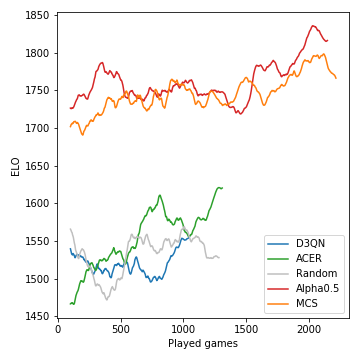6 nimmt! is an award-winning card game for two to ten players from 1994. Quoting Wikipedia:
The game has 104 cards, each bearing a number and one to seven bull's heads symbols that represent penalty points. A round of ten turns is played where all players place one card of their choice onto the table. The placed cards are arranged on four rows according to fixed rules. If placed onto a row that already has five cards then the player receives those five cards, which count as penalty points that are totaled up at the end of the round.
6 nimmt! is a competitive game of incomplete information and a large amount of stochasticity. Playing well requires a fair bit of planning. The simultaneous game play lends itself to mind games and bluffing, while some long-term strategy is necessary to avoid ending up in difficult end-game positions.
We implemented a slightly simplified version of 6 nimmt! as an OpenAI gym environment. Unlike in the original game, when playing a lower card than the last card on all stacks, the player cannot freely choose which stack to replace, but instead will always take the stack with the smallest number of penalty points.
So far we have implemented the following agents:
As a first test, we ran a simple self-play tournament. Starting with five untrained agents, we played 4000 games in total. For each game we randomly selected two, three, or four agents to play (and learn). Every 400 games we cloned the best-performing agent and kicked out some of the poorer-performing ones. In the end we just kept the best instance of each agent type.
Results over all games:
| Agent | Games played | Mean score | Win fraction | ELO |
|---|---|---|---|---|
| Alpha0.5 | 2246 | -7.79 | 0.42 | 1806 |
| MCS | 2314 | -8.06 | 0.40 | 1745 |
| ACER | 1408 | -12.28 | 0.18 | 1629 |
| D3QN | 1151 | -13.32 | 0.17 | 1577 |
| Random | 1382 | -13.49 | 0.19 | 1556 |
This is how the performance (measured in ELO) of the models developed during the course of the tournament:

Monte-Carlo tree search is crucial and leads to strong players. The model-free RL agents, on the other hand, struggle to even clearly outperform the random baseline. Due to the stochastic nature of the game, the win probabilities and ELO differences are not nearly as drastic as they could be, say, for chess. Note that we haven't tuned any of the many hyperparameters.
After this self-play phase, the Alpha0.5 agent faced Merle, one of the best 6 nimmt! players in our group of friends, for 5 games. These are the scores:
| Game | 1 | 2 | 3 | 4 | 5 | Sum |
|---|---|---|---|---|---|---|
| Merle | -10 | -16 | -11 | -3 | -4 | -44 |
| Alpha0.5 | -1 | -3 | -14 | -8 | -6 | -32 |
Assuming you have anaconda installed, clone the repo with
git clone [email protected]:johannbrehmer/rl-6nimmt.git
and create a virtual environment with
conda env create -f environment.yml
conda activate rl
Both agent self-play and games between a human player and trained agents are demonstrated in simple_tournament.ipynb.
Put together by Johann Brehmer and Marcel Gutsche.